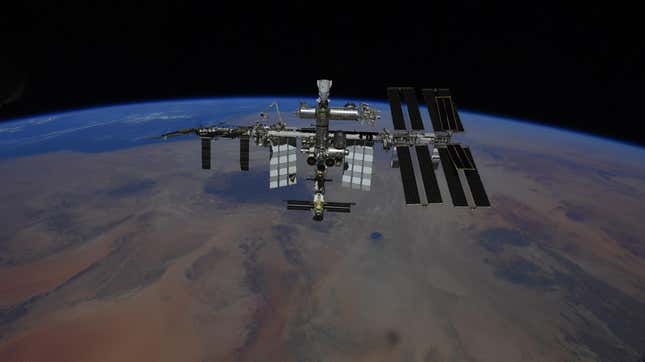
An impromptu “space debris evasion maneuver” has been scheduled to prevent errant space junk from slamming into the International Space Station, in what is becoming an increasingly routine procedure.
Preliminary calculations suggest the space junk will come to within 1,970 feet (600 meters) of the International Space Station on Thursday, November 11 at approximately 8:00 p.m. ET (Friday, November 12 at 4:00 a.m. Moscow time), according to Russian space agency Roscosmos. That’s too close for comfort, requiring the ISS to be positioned farther away from the danger zone. The maneuver is scheduled for Wednesday at 3:15 p.m. ET (11:15 p.m. Moscow time).
“The impact probability and risk to the International Space Station is very low,” a spokesperson from NASA explained in an email, adding that “the maneuver is a standard space station maneuver and does not require the crew to take any specific action.”
The sudden need to relocate the ISS is not expected to affect the launch of Crew-3, which blasts off later today from Kennedy Space Center in Florida, as NASA officials noted yesterday during the pre-flight news conference.
The offending chunk of junk is a remnant of the Fengyun-1C spacecraft. China deliberately destroyed its own weather satellite in January 2007 as part of an anti-satellite missile test. The event prompted howls of outrage, as experts criticized China for contributing to the militarization of space and for deliberately producing a dangerous cloud of orbital debris. A fictional version of this event was portrayed in the 2013 film Gravity, in which a rapidly expanding cloud of debris, accidentally caused by Russia shooting down a defunct spy satellite, destroyed the ISS.
To keep that story rooted in fiction, flight controllers plan to move the ISS by igniting the engines of Russia’s Progress MS-18 transport vehicle, currently docked to the station. The chosen impulse strength will move the space station at a rate of 2.3 feet per second (0.7 meters per second) for six minutes, according to Roscosmos. The maneuver will increase the space station’s altitude by 4,068 feet (1,240 meters), placing it in an operational orbit some 262 miles (421 km) above Earth.
The ISS has performed 29 avoidance maneuvers over the past 22 years, including three in 2020. The most recent happened on September 22, 2020, when space junk belonging to a Japanese rocket stage threatened to pass within 0.86 miles (1.39 kilometers) of the orbital outpost.
It’s an upward trend that’s likely to get worse over time, as satellites increasingly enter low Earth orbit and as the volume of orbital debris likewise increases—and as we continue to drag our collective feet and neglect to do anything meaningful, such as limiting the objects allowed in space or funding the development of satellites capable of cleaning up our orbital mess.
Correction: A previous version of this post incorrectly identified the Progress MS-18 as a Soyuz MS-18.
More: Space Force detects mystery object in orbit alongside Chinese satellite.